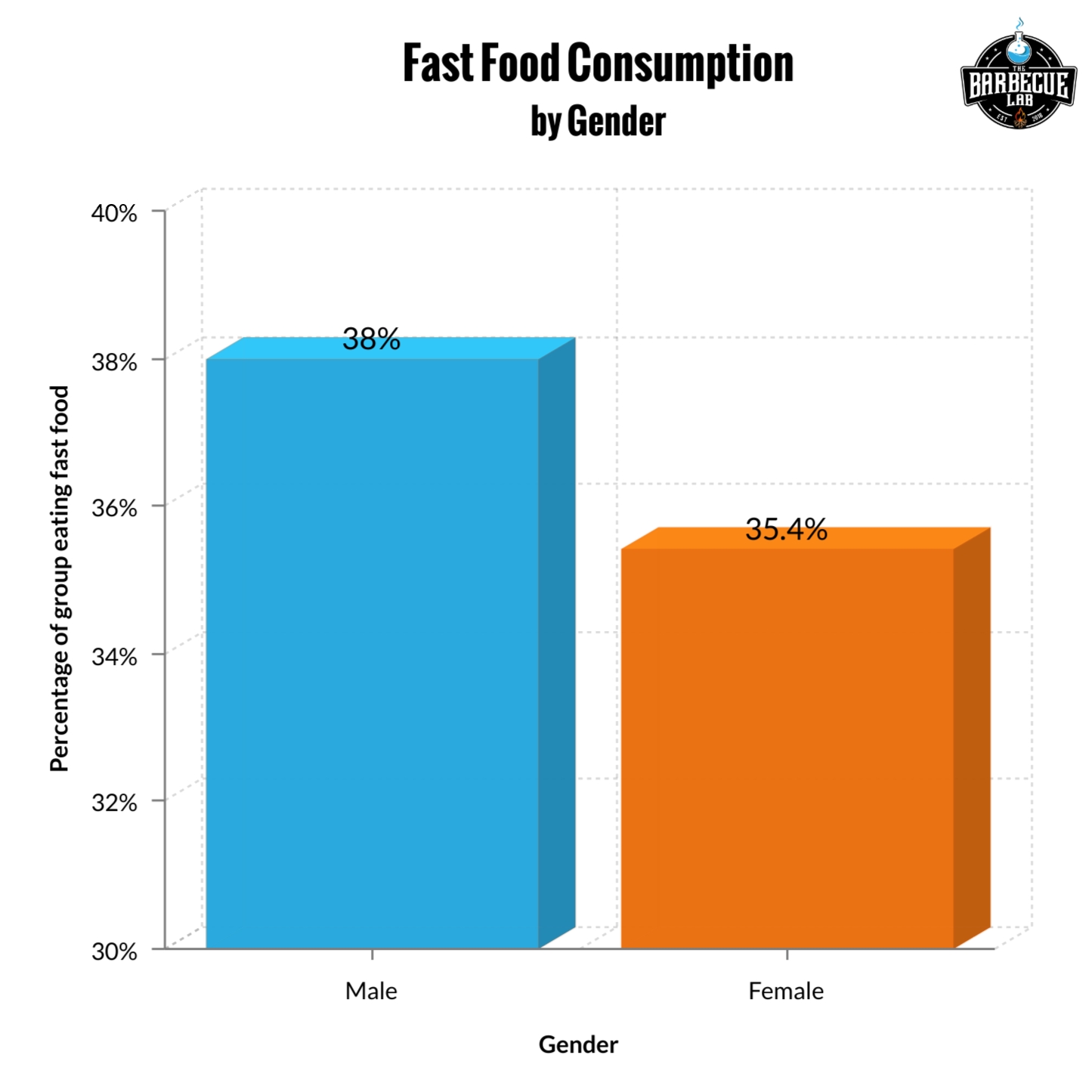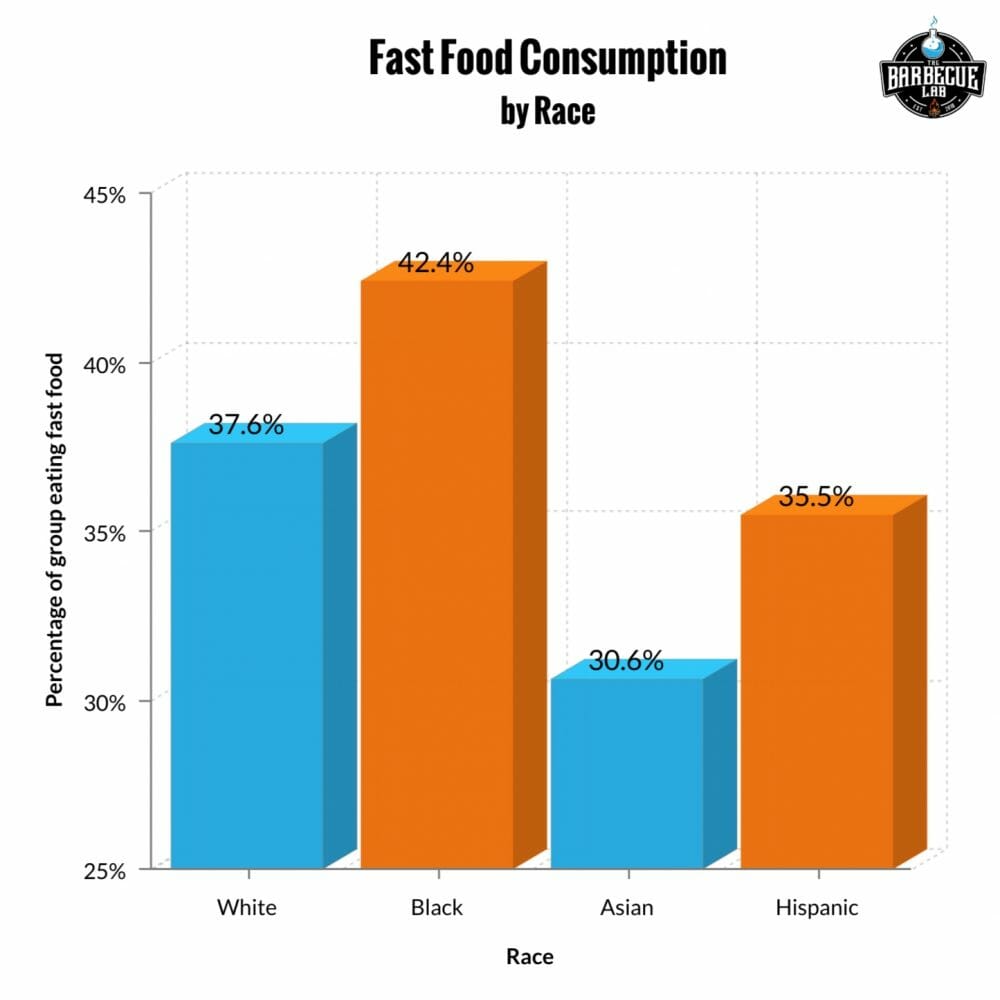What Percentage of Beef Consumed Is in Fast Food
Fast Food Consumption
How many times does the average person eat fast food per week?
Most Americans eat at a fast food restaurant 1-3 times a week. Statistics from a survey conducted by the National Center for Health Statistics from Center for Disease Control shows that a little over one-third (36.6%) of adults in America eat it on any given day. That's about 84.8 million adults eating fast food every day! Yikes!
Age
Does age play a role in consumption of fast food? We learned that 44.9% of Americans aged 20-39 eat fast food on any given day. Slightly less, you'll find 37.7% of the 40-59 years old population partaking, and only 24.1% of the 60+ crowd indulging in fast food. Do people younger than 60 eat out more because they are still in the workforce and have the income to do so? Maybe. People older than 60 are generally moving out of the workforce and now have time to cook for themselves at home. Fast food is expensive, too, and retirement can leave people with fixed incomes. It's possible that they are choosing to eat at home to be healthier and save money.

Gender
What about gender? It turns out that more men than women consume fast food on any given day, and the same report from the CDC shows that 38% of men are consuming it daily versus 35.4% of women.

Race
According to the data, it appears as though the group consuming fast food the most was the African American population, with 42.4% partaking on any given day. The Asian Americans consumed the least, with only 30.6% visiting fast food restaurants.

How much did Americans spend on fast food in 2019?
It's no secret that Americans eat a LOT of fast food. In 2018, the CDC reported that roughly one out of every 3 Americans were consuming some type of fast food on any given day.
The average American individually spends $1,200 a year on fast food alone, while the average American household spends around 10% of their income. That adds up to $110 billion dollars a year, which could end world hunger for up to three years.

Why is fast food so popular in America?
It saves time.
As a culture, we don't have the time to stop to prepare food or sit down and eat. Fast food in the United States is popular because it's just that - fast! Its convenience and speed make it an easy choice for families and people on the go. Most families in America (83% of them) eat it at least once a week. Many fast food meals are even eaten in the car, as much as 20%.
It's cheap.
Or so many people think. Fast food is relatively inexpensive compared with other restaurants. However, it's significantly more expensive than preparing food at home. In fact, about 32% of the people that eat fast food eat it because they think it is cheaper than the alternatives.
And while there is an idea out there that lower income families eat more fast food because of the "inexpensive costs," that idea is actually not based on the data. The numbers show that those with higher income tend to consume more fast food than those with lower incomes.
The National Center for Health Statistics, a division of the Center for Disease Control & Prevention, shows that 42% of adults that have a higher family income level eat fast food on any given day, while only 31.7% of adults in lower income brackets do so as well.

It's convenient.
With 826,000 fast food restaurants worldwide - this type of food is easy to find. Lunchtime is the most popular time for fast-food consumption, as 43.7% of consumers eat their fast food at this time, while dinner is a very close second at 42%.

It tastes good.
Fast food is high in calories and loaded with fat, sugar & salt. Most of the nutrition that would be present has been stripped away due to processing, so those things are added in order to make the food taste good. Combine that with a caffeine & sugar laden soft drink and it's no wonder we all hit that work day slump around 3 pm. Fast food might taste good - but it's not good for you.
Is fast-food consumption increasing?
The fast food industry continues to grow 2.2% a year. It's fair to say that despite all the health risks that accompany the regular consumption of fast food, it is still increasing. The fast food industry also currently employs 13 million people and has 826,000 restaurants and establishments world wide, so it's safe to say it's not going anywhere anytime soon.
Fast Food Health Risks
If you frequent fast food establishments, there are usually healthier options like salads & unsweetened tea available for purchase. These tend to be more expensive and harder to eat in the car (remember about 20% of fast food is eaten in the car). Value meals often include french fries and a sugary drink, and Americans love a good deal! But what does it really cost?
While there are many factors that lead to health problems, like stress and a sedentary lifestyle. Both of which might be why we turn to fast food in the first place - to save time & reduce the stressors of planning for and preparing food. Regular consumption of fast food certainly does not help you regain your health.
There are an average of 836 calories in a fast food meal. Also, on average adults in the United States eat 11.3% of their daily caloric intake from fast food. Children tend to eat 120 more calories per day on days when they eat fast food restaurant, and 34% of children eat fast food on a daily basis. For adults and kids alike, more fat, sugar and sodium are consumed on days when fast food is eaten than on days when all meals are prepared at home.
While the occasional fast food restaurant meal doesn't pose a huge risk, regular consumption starts posing significant health risks. Consumption of fast food at least twice a week can double your risk of type 2 diabetes as it can promote insulin resistance, and even just living near a fast food restaurant is linked to a 5.2 % greater risk of obesity. Type 2 diabetes and obesity both increase your risk for heart disease and a multitude of other illnesses. In fact, regular consumption of fast food not only increases your risk for heart disease, but can also increase your risk of depression by up to 51%. In order to manufacture food that can be cooked quickly and be relatively shelf stable, the process strips the food of it's vital nutrients. With the lack of proper nutrients combined with excessive intake of sodium and sugar, it's no wonder that we don't really feel good when we eat a lot of fast food.
The Most Popular Fast Food Chains
Despite all the media attention and warnings from physicians, the fast food industry remains popular among Americans and abroad. If we look at the amount of money that is spent on fast food, statistics show that McDonald's is king. Worldwide, adults spent a whopping $130.4 Billion at McDonald's in 2019. Starbucks was second worldwide with people spending $45.9 Billion there in 2019. That means almost 3 times more money was spent at the McDonald's fast food chain than at Starbucks last year. Could it be that McDonald's just has more stores than Starbucks? While, yes it is true that McDonald's has more establishments - we're not sure if the difference is enough to make up for the almost 3x more money spent there. At the end of 2018, Starbucks had 29,324 locations worldwide while McDonald's had 37,855.
In the United States, McDonald's is still the most popular fast food restaurant in every state. They even average selling 75 hamburgers a second. That's 4500 a minute, or 270,000 an hour.
Besides McDonalds and Starbucks, KFC, Subway, Domino's, Pizza Hut, Burger King, Tim Hortons, Chipotle & Taco Bell round out the top 10 Fast Food Restaurants as of 2022 when we look at the dollars spent there.

sartainnothavehou.blogspot.com
Source: https://thebarbecuelab.com/fast-food/
0 Response to "What Percentage of Beef Consumed Is in Fast Food"
Enregistrer un commentaire